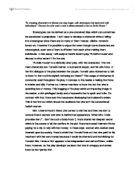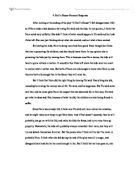Van Malderen
Jasmin Van Malderen
Humanities
11 September 2011
Often, besides portraying the dynamic changing character straightforward, authors will interweave a certain object that symbolizes the protagonist throughout the course of the story. A couple good examples of this can be shown using Nathanial Hawthorne’s The Scarlet Letter and Henrik Ibsen’s A Doll’s House. While both have different symbols, they both portray the women protagonists in the story, its meanings changing over time. For The Scarlet Letter, the protagonist Hester Prynne’s symbol is the letter "A" sewn onto her dress while in A Doll’s House, Nora Helmer’s symbol is the Christmas tree her family gets for the holidays. In the beginning of the book, each symbol means one thing, while at the end of the story it takes on a completely new meaning, almost the opposite.
In The Scarlet Letter, Hester Prynne’s symbolic letter “A” retains a benevolent meaning by the end of the story, while at the beginning that was far from, somewhat opposite, of what it was supposed to mean. Adulterer. Accused of committing adultery while waiting years for her husband to come home to her, a scarlet letter “A” is embroidered upon the chest of Hester. In the beginning of the novel, in fact, the letter is depicted as an obnoxious “token of shame” that stands out on her bosom while she is standing upon the scaffold for the whole world to see her. And when she is holding her baby in front of her, evidence of her so called crime, it is said that “one token of her shame would but poorly serve to hide another”. From the beginning of the novel, described as the “wearer of the scarlet letter” instead of her name Hester, the letter came to define her and made her lose all the other aspects of herself. Throughout the course of the story, events constantly happen to remind her of the scarlet letter she shamefully seems to bear. In one instant at Governor Bellingham’s house when her daughter is looking at some armor, Hester notices that it is like a convex mirror and “the scarlet letter was represented in exaggerated and gigantic proportions, so as to be greatly the most prominent feature or her appearance.” In another part of the story, Hester’s daughter Pearl starts “gathering handfuls of wild flowers, and flinging them, one by one, at her mother’s bosom; dancing up and down, like a little elf, whenever she hit the scarlet letter.” Yet again, to Hester it is another moment constantly reminding her of what she did. The change all starts in Chapter thirteen, called Another View of Hester, the title alone foreshadowing a change in meaning of the symbol. The symbol not only becomes forgotten and disregarded; it becomes almost sacred and symbolizes someone of a higher status. Described with a positive connotation, “glittering in its fantastic embroidery”, the letter is now a familiar object to the townspeople. Hester became a shoulder to cry on; one to aid those in need, feed the poor, and cure the sick. Able.







